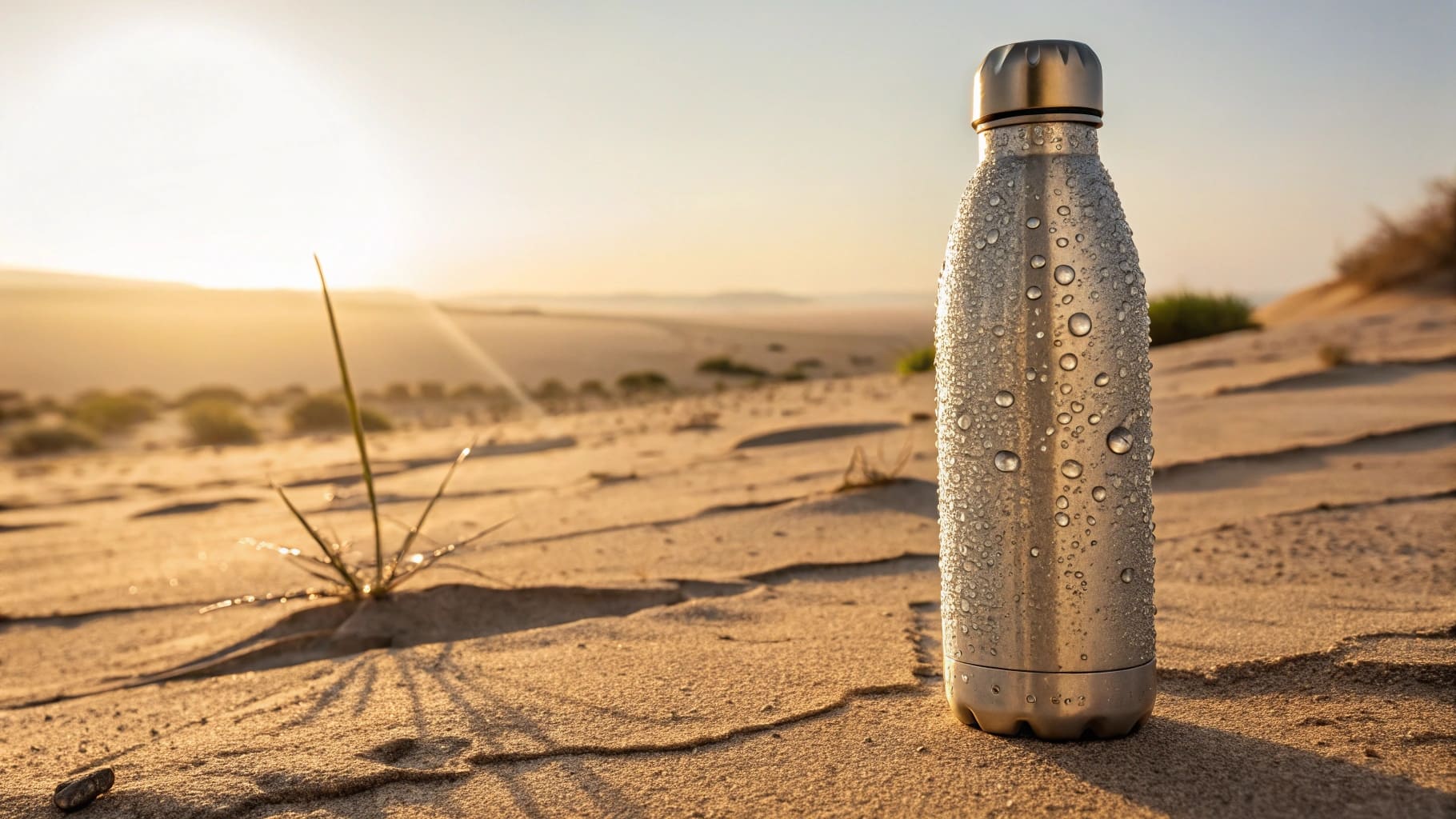Choosing bottle materials is tough. Bad choices can hurt your brand and profits. Stainless steel often offers the best B2B solution for most companies.
For most businesses, food-grade stainless steel is supreme. It offers safety, durability, and versatility for branding. This makes it a reliable choice for B2B, unlike copper which has more limitations and potential issues for general consumers.

When you're looking to source water bottles for your brand, the material choice is one of the first big decisions. It affects everything from cost to customer satisfaction. I want to help you understand the options so you can make the best choice for your business. Let's explore why this matters so much.
What Is The Best Material For A Water Bottle From A Business Perspective?
Overwhelmed by bottle material choices? The wrong pick costs you time and money. Understand key factors to select the best for your business needs.
Stainless steel is often the best material for B2B. It's safe for many drinks, very strong, easy to clean, and great for custom logos. This makes it a top pick for businesses wanting wide appeal and reliability.

When I talk to procurement officers like Mark Shenng, or startup bosses looking to launch a new drinkware line, the conversation always comes back to reliability and marketability. From my experience at Icobottle, food-grade stainless steel, particularly types 304 (18/8) and sometimes 316, consistently meets these needs.
Here’s a breakdown of its advantages:
- Safety and Inertness: Stainless steel doesn't react with beverages. This is crucial. Whether your customers fill their bottles with water, acidic fruit juice, or hot coffee, the taste remains pure. There's no metallic leaching to worry about, which is a big plus for consumer safety and reduces potential liability for your brand.
- Durability: These bottles are tough. They resist rust, corrosion, and impacts much better than many alternatives. This means a longer product lifespan and happier customers.
- Customization: Stainless steel surfaces are ideal for various branding techniques. We can do laser engraving, screen printing, or full-color wraps. This allows businesses to create a product that truly represents their brand.
- Market Appeal: Consumers recognize and trust stainless steel. It has a premium feel and is associated with eco-friendliness as a reusable alternative to plastic.
Consider these factors when choosing:
| Feature | Stainless Steel (304/316) | Implication for B2B |
|---|---|---|
| Reactivity | Low (Inert) | Safe for all drink types, preserves taste. |
| Durability | High | Long product life, fewer returns/complaints. |
| Customization | Excellent | Wide range of branding options. |
| Cleaning | Easy | Hygienic, user-friendly. |
| Cost | Moderate | Good balance of quality and price for wholesale. |
| Perceived Value | High | Supports premium branding and pricing. |
While other materials exist, stainless steel provides the best all-around package for businesses aiming for a wide audience and a dependable product. This is why we see it as the industry standard.
What Are The Disadvantages Of Copper Water Bottles For Importers?
Copper bottles look trendy, but what are the risks? Hidden issues can damage your brand. It is important to know the downsides before investing.
Copper bottles can react with acidic drinks. They may leach copper if water is stored too long. They also cost more and appeal to a smaller market. This means more risk for importers.

While copper bottles have a certain aesthetic and are linked to traditional practices, for B2B clients, especially those in America and Europe, the disadvantages often outweigh the perceived benefits. I've seen businesses explore copper, but many, like my typical customer Mark who values quality and competitive pricing, find stainless steel a safer bet.
Here are key concerns:
- Reactivity and Safety:
- Acidic Beverages: Copper reacts with acidic liquids like fruit juice, lemonade, or even some teas. This reaction can alter the taste of the drink and, more importantly, lead to increased copper ingestion.
- Copper Leaching: Even with plain water, if it's stored in a copper bottle for extended periods (e.g., more than a few hours, especially if unlined), copper can leach into the water. While small amounts of copper are essential for health, excessive intake can be harmful. This is a significant liability concern. Many copper bottles sold for Ayurveda are unlined for direct contact.
- Higher Costs and Niche Market:
- Material & Production: Copper is generally more expensive than stainless steel. Manufacturing can also be more complex, leading to higher unit costs.
- Limited Appeal: The market for copper bottles is much smaller than for stainless steel. It's a niche product, often appealing to those specifically interested in Ayurveda or its unique look. This limits sales volume for a general wholesaler or brand.
- Maintenance and Tarnishing:
- Copper tarnishes easily. It requires regular cleaning with special solutions (like lemon and salt, or tamarind paste) to maintain its shine. This higher maintenance can be a drawback for many consumers.
- They are also generally not dishwasher safe, which is a convenience many users expect.
- Durability: Copper is a softer metal than stainless steel. This means it's more prone to dents and scratches, potentially leading to a shorter lifespan or a less pristine appearance over time.
For a procurement officer focusing on quality inspection, certification, and minimizing issues, copper presents more hurdles. The risk of customer complaints due to taste changes, health concerns, or maintenance challenges is higher. This is why, from a B2B wholesale perspective, it's a more difficult product to scale successfully compared to stainless steel.
What Are The Benefits Of A Copper Water Bottle, And Are They Relevant For B2B?
Curious about copper's unique appeal? Some claim health benefits. Let's look at what they are from a practical business viewpoint for importers.
Copper is known for antimicrobial claims and its Ayurvedic history. These can be selling points for a niche market. But, businesses must weigh these against practical B2B concerns like safety and wider appeal.

It's true that copper bottles are marketed with certain benefits, primarily stemming from traditional Ayurvedic practices and the inherent properties of copper. As a supplier, I think it's important to understand these claims but also to critically assess their relevance for a B2B model focused on mass markets in America and Europe.
Here's a look at the common claims:
- Antimicrobial Properties:
- The Claim: Copper surfaces have been shown to kill certain bacteria and viruses upon contact (oligodynamic effect). This is often a major selling point.
- B2B Reality: While scientifically supported to some extent, the conditions under which this works effectively inside a water bottle (contact time, water pH, etc.) are specific. It's not a substitute for regular cleaning. For a business, overstating these benefits without robust, context-specific proof can be misleading. Relying on this as a primary health feature for a broad audience is risky. Certifications for such claims can also be complex to obtain and maintain.
- Ayurvedic Tradition:
- The Claim: Storing water in copper vessels (Tamra Jal) is an ancient Ayurvedic practice believed to balance the body's "doshas" and provide health benefits.
- B2B Reality: This appeals to a specific wellness-oriented niche. While this niche exists and can be profitable, it's not mainstream. For a large-scale importer or brand, catering solely to this can limit market reach. Mark Shenng, for instance, focusing on broad distribution in Canada, would likely find this too specialized.
- Aesthetic Appeal:
- The Claim: Copper has a unique, warm aesthetic that many find attractive. It can look very premium and distinctive.
- B2B Reality: This is a valid point. The look is certainly different. However, this must be weighed against the maintenance (tarnishing) and durability issues mentioned earlier. If the aesthetic is key, protective coatings might be needed, which can add cost or negate some of the direct copper-contact benefits.
While these benefits can carve out a market, for B2B clients prioritizing safety, broad appeal, ease of use, and reliable supply chains, these benefits often don't outweigh the practical disadvantages and potential liabilities associated with copper. The product becomes more of a specialty item than a staple.
Conclusion
For most businesses, stainless steel water bottles offer superior safety, versatility, and marketability. This makes them the pragmatic choice over copper for B2B success.

